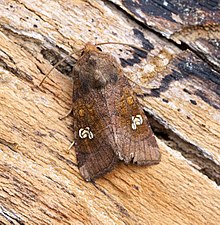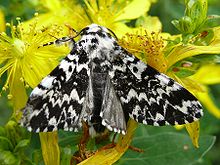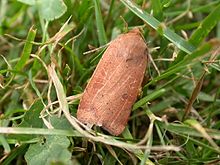Noctuidae
| Owlet moths | |
|---|---|

| |
| Amphipoea oculea | |

| |
| Panthea coenobita | |
| Scientific classification | |
| Domain: | Eukaryota |
| Kingdom: | Animalia |
| Phylum: | Arthropoda |
| Class: | Insecta |
| Order: | Lepidoptera |
| Superfamily: | Noctuoidea |
| Family: | Noctuidae Latreille,1809 |
| Type species | |
| Noctua pronuba | |
| Subfamilies | |
| |
| Diversity | |
| About 11,772 species | |
TheNoctuidae,commonly known asowlet moths,cutwormsor armyworms, are afamilyofmoths.They are considered the most controversial family in the superfamilyNoctuoideabecause many of thecladesare constantly changing, along with the other families of the Noctuoidea.[1][2][3]It was considered the largest family in Lepidoptera for a long time, but after regroupingLymantriinae,CatocalinaeandCalpinaewithin the familyErebidae,the latter holds this title now.[4]Currently, Noctuidae is the second largest family in Noctuoidea, with about 1,089generaand 11,772 species.[5]This classification is still contingent, as more changes continue to appear between Noctuidae and Erebidae.
Description[edit]

Adult:Most noctuid adults have wings with a variety of shades of browns, grays, and other varied shades and colourations but some subfamilies, such asAcronictinaeandAgaristinae,are very colorful, especially those from tropical regions (e.g.Baorisa hieroglyphica). They are characterized by a structure in themetathoraxcalled the nodular sclerite or epaulette, which separates the tympanum and the conjunctiva in thetympanal organ.It functions to keepparasites(Acari) out of the tympanal cavity. Another characteristic in this group is trifine hindwing venation, by reduction or absence of the second medial vein (M2).[6]
Markings present on the wings of noctuid adults can be helpful in distinguishing species. From the basal location to the outer edge (proximal to distal) on the forewing, there is a claviform (club-shaped) stigma, horizontally oriented with the thicker end closer to the wing's outer edge, located posterior to a discal (round) stigma.[7]These are followed distally by a reniform (kidney-shaped) stigma,[8]which is typically oriented with its concave side facing the wing's outer edge. It is often not possible to discern all of the stigmata on all specimens or species.[7]Crossbands or crosslines may be present, oriented longitudinally from the leading to the trailing edge of the wing.[8]
Larva:Commonly green or brown; some species present bright colors, such as the camphorweed cucullia moth (Cucullia alfarata). Most are pudgy and smooth with rounded short heads and few setae, but there are some exceptions in some subfamilies (e.g.AcronictinaeandPantheinae).[9]
Pupa:The pupae most often range from shiny brown to dark brown. When they newly pupate they are bright brownish orange, but after a few days start to get darker.
Eggs:Vary in colors, but all have a spherical shape.
Etymology[edit]
The word Noctuidae is derived from the name of the type genusNoctua,which is the Latin name for thelittle owl,and the patronymic suffix -idae used typically to form taxonomic family names in animals.[10]
The common name "owlet"originally means a small or young owl. The names" armyworms "and" cutworms "are based on the behavior of the larvae of this group, which can occur in destructive swarms and cut the stems of plants.[11]
Ecology[edit]
Distribution and diversity[edit]

This family is cosmopolitan and can be found worldwide except in theAntarctic region.Some species, such as the setaceous Hebrew character (Xestia c-nigrum), can be found in theArctic Circle,specifically in theYukonterritory of westernCanada,with an elevation 1,702 m above sea level, where the temperature fluctuates between 23/-25 °C (73/-13 °F).[12]Many species of dart moths have been recorded in elevations as high as 4,000 m above sea level (e.g.Xestia elisabetha).[13] Among the places where the number of species has been counted are North America and northernMexico,with about 2,522 species. 1,576 species are found in Europe, while the other species are distributed worldwide.[3][14][15][16][17]
Mutualism[edit]

Members of Noctuidae, like other butterflies and moths, perform an important role in plantpollination.Some species have developed a stronger connection with their host plants. For example, the lychnis moth (Hadena bicruris) has a strange mutualistic relationship with pink plants or carnation plants (Caryophyllaceae), in that larvae feed on the plant while the adults pollinate the flowers.[18]

Food guilds[edit]
Herbivory:Caterpillars of most Noctuidae feed on plants; some feed on poisonous plants and are unaffected by their chemical defences; for example, the splendid brocade moth (Lacanobia splendens) feeds on cowbane (Cicuta virosa), a plant that is notoriously toxic to vertebrates.[19]
Predationandcannibalism:During the larval stage, some cutworms readily feed on other insects. One such species is the shivering pinion (Lithophane querquera), whose larvae commonly feed on other lepidopteran larvae.[20]Moreover, many noctuid larvae, such as those of the fall armyworm (Spodoptera frugiperda) and of genera such asHeliothisandHelicoverpa,aggressively eat their siblings and often other species of caterpillar.[21]
Nectarivoryandpuddling:Like manyLepidoptera,many species of adult Noctuidae visit flowers for their nectar. They also seek other liquid food resources such as plant juices,honeydew,dung, urea and mud, among others.[22]
As is common in members of the order Lepidoptera, courtship in many Noctuidae includes a set of movements in which the female evaluates the male's reproductive fitness.[22]
Most noctuid moths producepheromonesthat attract the opposite sex. Female pheromones that attract males occur widely and have long been studied, but the study of male pheromones has further to go.[22][23][24]
Reproduction[edit]

Noctuid moths commonly begin the reproductive season from spring to fall, and mostly aremultivoltine,such as the eastern panthea moth (Panthea furcilla), which reproduces over the year.[25]Nevertheless, some species have just one brood of offspring (univoltine); among the best known is the lesser yellow underwing (Noctua comes).[25]
Defense[edit]

This group has a wide range of both chemical and physical defenses. Among the chemical defenses three types stand out. First, thepyrrolizidine alkaloid sequestrationusually present inArctiinaeis also found in a few species of noctuids, including the Spanish moth (Xanthopastis timais).[26]Another chemical defense isformic acidproduction, which was thought to be present only inNotodontidae,but later was found in caterpillars ofTrachosea champa.[27]Finally, the last type of chemical defense is regurgitation of plant compounds, often used by many insects, but the cabbage palm caterpillar (Litoprosopus futilis) produces a toxin called toluquinone that deters predators.[28]
On the other hand, the main physical defense in caterpillars and adults alike ismimicry.Most owlet moths have drab colors with a variety of patterns suitable to camouflage their bodies.[25]The second physical defense consists in thousands of secondary setae that surround the body. The subfamilies that present this mechanism arePantheinaeandAcronictinae.The third isaposematism,represented by species ofCucullinae.[25]Finally, all adults have another mechanism for defense: atympanal organavailable to hear the echolocation spread out by bats, so the moths can avoid them.[29]
Human importance[edit]

Agriculture[edit]
Many species of owlet moths are considered an agricultural problem around the world. Their larvae are typically known as "cutworms" or "armyworms" due to enormous swarms that destroy crops, orchards and gardens every year. The Old World bollworm (Helicoverpa armigera) produces losses in agriculture every year that exceed US$2 billion.[30]Additionally, the variegated cutworm (Peridroma saucia) is described by many as one of the most damaging pests to vegetables.[31]
In West Africa, species includingBusseola fusca,Heliocheilus albipunctella,Sesamia calamistis,Helicoverpa armigera,andSpodoptera exemptaare major pests of staple crops such aspearl millet,sorghum,andmaize.[32]
Systematics[edit]
Since molecular analysis began to play a larger role insystematics,the structure of many Lepidoptera groups has been changing and Noctuidae is not an exception. Most recent studies have shown that Noctuidaesensu strictois amonophyleticgroup, mainly based on trifine venation. Some clades within Noctuidaesensu latohave yet to be studied. This taxonomic division represents the subfamilies, tribes and subtribes considered so far.[1][14][33][34]
- Family NoctuidaeLatreille, 1809
- SubfamilyAcontiinaeGuenée, 1841
- TribeAcontiiniGuenée, 1841
- TribeArmadini
- TribeChamaecleini
- SubfamilyAcronictinaeHarris, 1841
- SubfamilyAediinae
- SubfamilyAgaristinaeBoisduval, 1833
- SubfamilyAmphipyrinaeGuenée, 1837
- TribeAmphipyriniGuenée, 1837
- TribePsaphidiniGrote, 1896
- SubtribeFeraliinaPoole, 1995
- SubtribeNocloinaPoole, 1995
- SubtribePsaphidinaGrote, 1896
- SubtribeTriocnemidinaPoole, 1995
- SubfamilyBagisarinaeCrumb, 1956
- SubfamilyBalsinaeGrote, 1896
- SubfamilyBryophilinaeGuenée, 1852
- SubfamilyCobubathinaeWagner & Keegan, 2021
- SubfamilyCondicinaePoole, 1995
- TribeCondiciniPoole, 1995
- TribeLeuconyctiniPoole, 1995
- SubfamilyCropiinaeKeegan & Wagner, 2021
- SubfamilyCuculliinaeHerrich-Schäffer, 1850
- SubfamilyDilobinae
- SubfamilyDyopsinae
- SubfamilyEriopinaeHerrich-Schäffer, 1851
- SubfamilyEucocytiinae
- SubfamilyEustrotiinaeGrote, 1882
- SubfamilyGrotellinae
- SubfamilyHeliothinaeBoisduval, 1828
- SubfamilyMetoponiinaeHerrich-Schäffer, 1851
- TribeCydosiiniKitching & Rawlins, 1998
- SubfamilyNoctuinaeLatreille, 1809
- TribeActinotiiniBeck, 1996
- TribeApameiniGuenée, 1841
- TribeArzaminiGrote, 1883
- TribeCaradrininiBoisduval, 1840
- SubtribeAthetiinaFibiger & Lafontaine, 2005
- SubtribeCaradrininaBoisduval, 1840
- TribeDypterygiiniForbes, 1954
- TribeElaphriiniBeck, 1996
- TribeEpisemini
- TribeEriopyginiFibiger & Lafontaine, 2005
- TribeGlottuliniGuenée, 1852
- TribeHadeniniGuenée, 1837
- TribeLeucaniiniGuenée, 1837
- TribeNoctuiniLatreille, 1809
- TribeOrthosiiniGuenée, 1837
- TribePhlogophoriniHampson, 1918
- TribePhosphiliniPoole, 1995
- TribeProdeniiniForbes, 1954
- TribePseudeustrotiiniBeck, 1996
- TribeTholeriniBeck, 1996
- TribeXyleniniGuenée, 1837
- SubtribeAntitypinaForbes & Franclemont, 1954
- SubtribeCosmiinaGuenée, 1852
- SubtribeUfeinaCrumb, 1956
- SubtribeXyleninaGuenée, 1837
- SubfamilyOncocnemidinaeForbes & Franclemont, 1954
- SubfamilyPantheinaeSmith, 1898
- SubfamilyPlusiinaeBoisduval, 1828
- TribeAbrostoliniEichlin & Cunningham, 1978
- TribeArgyrogrammatiniEichlin & Cunningham, 1978
- TribePlusiiniBoisduval, 1828
- SubtribeAutoplusiinaKitching, 1987
- SubtribeEuchalciinaChou & Lu, 1979
- SubtribePlusiinaBoisduval, 1828
- SubfamilyRaphiinae
- SubfamilyStiriinae
- TribeAnnaphilini
- TribeStiriiniGrote, 1882
- SubtribeAnnaphilinaMustelin, 2006
- SubtribeAzeniinaPoole, 1995
- SubtribeGrotellinaPoole, 1995
- SubtribeStiriinaGrote, 1882
Genera with intervening taxonomy not available include:
- Alastria
- Epilitha
- Fabula
- Lanatopyga
- Lenisa
- Neoligia
- Orohadena
- Orthomoia
- Protapamea
- Proxenus
- Pseudluperina
References[edit]
- ^abRegier, Jerome C.; Mitter, Charles; Mitter, Kim; Cummings, Michael P.; Bazinet, Adam L.; Hallwachs, Winifred; Janzen, Daniel H.; Zwick, Andreas (1 January 2017)."Further progress on the phylogeny of Noctuoidea (Insecta: Lepidoptera) using an expanded gene sample".Systematic Entomology.42(1): 82–93.Bibcode:2017SysEn..42...82R.doi:10.1111/syen.12199.ISSN1365-3113.
- ^Lafontaine, J. Donald; Fibiger, Michael (1 October 2006). "Revised higher classification of the Noctuoidea (Lepidoptera)".The Canadian Entomologist.138(5): 610–635.doi:10.4039/n06-012.ISSN1918-3240.S2CID86122393.
- ^abMichael, Fibiger; Donald, Lafontaine, J.; H., Hacker, Hermann (1 January 2005).A Review of the Higher Classification of the Noctuoidea (Lepidoptera) With Special Reference to the Holarctic Fauna. Beilage zu Band 11: (Notodontidae, Nolidae, Arctiidae, Lymantriidae, Erebidae, Micronoctuidae, and Noctuidae): Gesamtinhaltsverzeichnis Bände 1-10: Indices Bände 1-10.Delta-Druck und Verlag Peks.ISBN978-3938249017.OCLC928877801.
{{cite book}}:CS1 maint: multiple names: authors list (link) - ^Zahiri, Reza; Holloway, Jeremy D.; Kitching, Ian J.; Lafontaine, J. Donald; Mutanen, Marko; Wahlberg, Niklas (1 January 2012)."Molecular phylogenetics of Erebidae (Lepidoptera, Noctuoidea)".Systematic Entomology.37(1): 102–124.Bibcode:2012SysEn..37..102Z.doi:10.1111/j.1365-3113.2011.00607.x.ISSN1365-3113.S2CID84249695.
- ^Zhang, Z.-Q., ed. (23 December 2011)."Animal biodiversity: An outline of higher-level classification and survey of taxonomic richness".Zootaxa.3148.Magnolia Press: 217.ISBN9781869778491.
- ^Fibiger, Michael (2007).The Lepidoptera of Israel.Coronet Books Incorporated.ISBN9789546422880.Archivedfrom the original on 2024-05-17.Retrieved2017-04-01.
- ^abHudson, G.V. (1898). "I.—The Caradrinina".New Zealand Moths and Butterflies (Macro-Lepidoptera).London: West, Newman & Co.Retrieved31 July2022.
- ^abRackham, Tony."Moths - Glossary".Identify British Moths.Retrieved31 July2022.
- ^Wagner, David L. (25 April 2010).Caterpillars of Eastern North America: A Guide to Identification and Natural History.Princeton University Press.ISBN978-1400834143.Archivedfrom the original on 17 May 2024.Retrieved5 June2020.
- ^Speidel, W.; Naumann, C. M. (2004). "A survey of family-group names in noctuoid moths (Insecta: Lepidoptera)".Systematics and Biodiversity.2(2): 191–221.Bibcode:2004SyBio...2..191S.doi:10.1017/S1477200004001409.ISSN1477-2000.S2CID85652010.
- ^Rice, Marlin E. (1 January 2004)."Armyworm defoliating young corn".Integrated Crop Management News.
- ^Lafontaine, J. D.; Wood, D. M."Butterflies and moths of the Yukon"(PDF).E.H. Strickland Entomological Museum.
- ^Gyulai, P.; Ronkay, L.; Saldaitis, A. (4 November 2013). "Two newXestiaHübner, 1818 species from China (Lepidoptera, Noctuidae) ".Zootaxa.3734(1): 96–100.doi:10.11646/zootaxa.3734.1.12.ISSN1175-5334.PMID25277901.S2CID21336866.
- ^abSchmidt, B. Christian; Lafontaine, J. Donald (19 March 2010).Annotated Check List of the Noctuoidea (Insecta, Lepidoptera) of North America North of Mexico.PenSoft Publishers LTD.ISBN9789546425355.Archivedfrom the original on 17 May 2024.Retrieved8 October2020.
- ^Schmidt, Bjorn Christian; Lafontaine, J. Donald (24 November 2011).Contributions to the Systematics of New World Macro-moths III.PenSoft Publishers LTD. pp. 1–4.doi:10.3897/zookeys.149.2383.ISBN9789546426185.PMC3234404.PMID22207789.Archivedfrom the original on 17 May 2024.Retrieved8 October2020.
{{cite book}}:|journal=ignored (help) - ^Lafontaine, Donald; Schmidt, Christian (2 June 2013)."Additions and corrections to the check list of the Noctuoidea (Insecta, Lepidoptera) of North America north of Mexico".ZooKeys(264): 227–236.Bibcode:2013ZooK..264..227L.doi:10.3897/zookeys.264.4443.ISSN1313-2970.PMC3668382.PMID23730184.
- ^Lafontaine, J. Donald; Schmidt, B. Christian (15 October 2015)."Additions and corrections to the check list of the Noctuoidea (Insecta, Lepidoptera) of North America north of Mexico III".ZooKeys(527): 127–147.Bibcode:2015ZooK..527..127L.doi:10.3897/zookeys.527.6151.ISSN1313-2989.PMC4668890.PMID26692790.
- ^Bopp, Sigrun; Gottsberger, Gerhard (1 January 2004). "Importance ofSilene latifoliassp.albaandS. dioica(Caryophyllaceae) as Host Plants of the Parasitic PollinatorHadena bicruris(Lepidoptera, Noctuidae) ".Oikos.105(2): 221–228.Bibcode:2004Oikos.105..221B.doi:10.1111/j.0030-1299.2004.12625.x.JSTOR3548083.
- ^Jacobs, Maarten (2005)."Lacanobia splendens,a new species for the Belgian fauna (Lepidoptera: Noctuidae) "(PDF).Phegea.33(3): 83–85.
- ^Schweitzer, D. F. (1 January 1979)."Predatory behavior inLithophane querqueraand other spring caterpillars ".Journal of the Lepidopterists' Society.ISSN0024-0966.
- ^Chapman, Jason W.; Williams, Trevor; Martínez, Ana M.; Cisneros, Juan; Caballero, Primitivo; Cave, Ronald D.; Goulson, Dave (1 January 2000). "Does Cannibalism inSpodoptera frugiperda(Lepidoptera: Noctuidae) Reduce the Risk of Predation? ".Behavioral Ecology and Sociobiology.48(4): 321–327.doi:10.1007/s002650000237.JSTOR4601817.S2CID3947934.
- ^abcBirch, Martin (1 May 1970). "Pre-courtship use of abdominal brushes by the nocturnal moth,Phlogophora meticulosa(L.) (Lepidoptera: Noctuidae) ".Animal Behaviour.18, Part 2: 310–316.doi:10.1016/S0003-3472(70)80043-4.
- ^Heath, R. R.; Mclaughlin, J. R.; Proshold, F.; Teal, P. E. A. (1 March 1991). "Periodicity of Female Sex Pheromone Titer and Release inHeliothis subflexaandH. virescens(Lepidoptera: Noctuidae) ".Annals of the Entomological Society of America.84(2): 182–189.doi:10.1093/aesa/84.2.182.ISSN0013-8746.
- ^Ronkay, L. (2005)."Revision of the genusLophotergesHampson, 1906 (s. l.) (Lepidoptera, Noctuidae, Cuculliinae). Part II. The genusLophotergess. str ".Acta Zoologica Academiae Scientiarum Hungaricae.51:1–57.
- ^abcdWagner, David L.; Schweitzer, Dale F.; Sullivan, J. Bolling & Reardon, Richard C. (2011).Owlet Caterpillars of Eastern North America.Princeton University Press.ISBN978-0691150420.
- ^Vilanova, Cristina; Baixeras, Joaquín; Latorre, Amparo; Porcar, Manuel (1 January 2016)."The Generalist Inside the Specialist: Gut Bacterial Communities of Two Insect Species Feeding on Toxic Plants Are Dominated byEnterococcussp ".Frontiers in Microbiology.7:1005.doi:10.3389/fmicb.2016.01005.ISSN1664-302X.PMC4923067.PMID27446044.
- ^Nakamura, M. (1998)."The eversible cervical gland and the chemical component of its secretion in noctuid larvae"(PDF).Transactions of the Lepidopterological Society of Japan.49:85–92.Archived(PDF)from the original on 2024-05-17.Retrieved2017-04-01.
- ^Smedley, Scott R.; Ehrhardt, Elizabeth; Eisner, Thomas (1993)."Defensive Regurgitation by a Noctuid Moth Larva (Litoprosopus futilis) ".Psyche: A Journal of Entomology.100(3–4): 209–221.doi:10.1155/1993/67950.ISSN0033-2615.
- ^Kristensen, Niels (1 January 2003).Handbook of Zoology.Vol. 2: Morphology, Physiology, and Development. Walter de Gruyter.ISBN9783110893724.Archivedfrom the original on 17 May 2024.Retrieved8 October2020.
- ^Narayanamma, V. Lakshmi; Sharma, H. C.; Gowda, C. L. L.; Sriramulu, M. (1 December 2007)."Incorporation of lyophilized leaves and pods into artificial diets to assess the antibiosis component of resistance to pod borerHelicoverpa armigera(Lepidoptera: Noctuidae) in chickpea "(PDF).International Journal of Tropical Insect Science.27(3–4): 191–198.doi:10.1017/S1742758407878374.ISSN1742-7592.S2CID86757646.
- ^Capinera, John L. (2008). "Variegated Cutworm, Peridroma saucia (Hübner) (Lepidoptera: Noctuidae)". In Capinera, John L. (ed.).Encyclopedia of Entomology.Springer Netherlands. pp. 4038–4041.doi:10.1007/978-1-4020-6359-6_3936.ISBN9781402062421.
- ^Heath, Jeffrey."Guide to insects, arthropods, and molluscs of northern Dogon country".Archivedfrom the original on 2021-03-07.Retrieved2021-02-23.
- ^Keegan, Kevin; Rota, Jadranka; Zahiri, Reza; Zilli, Alberto; et al. (2021)."Toward a Stable Global Noctuidae (Lepidoptera) Taxonomy".Insect Systematics and Diversity.5(3).doi:10.1093/isd/ixab005.Archivedfrom the original on 2024-05-17.Retrieved2021-11-19.
- ^Wagner, David L.; Keegan, Kevin; Bugh, Valerie G. (2019)."A Tale of Two Caterpillars and Reclassification of Cerathosia Smith and Cydosia Duncan [& Westwood] (Lepidoptera: Noctuidae)".Journal of the Lepidopterists' Society.73(1): 1.doi:10.18473/lepi.73i1.a1.Archivedfrom the original on 2024-05-17.Retrieved2021-11-19.
External links[edit]
- OnUniversity of FloridaInstitute of Food and Agricultural SciencesFeatured Creatures web site:
- Agrotis ipsilon,black cutworm
- Diphthera festiva,hieroglyphic moth
- Litoprosopus futilis,cabbage palm caterpillar
- Pseudaletia unipuncta,true armyworm
- Spodoptera eridania,southern armyworm
- Spodoptera frugiperda,fall armyworm
- Spodoptera ornithogalli,yellowstriped armyworm
- Xanthopastis timais,Spanish moth or convict caterpillar
- Images of Noctuidae species in New ZealandArchived2015-11-07 at theWayback Machine
